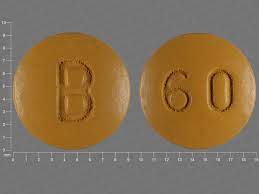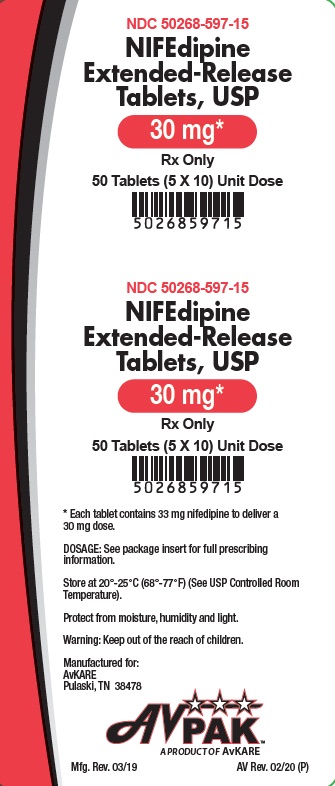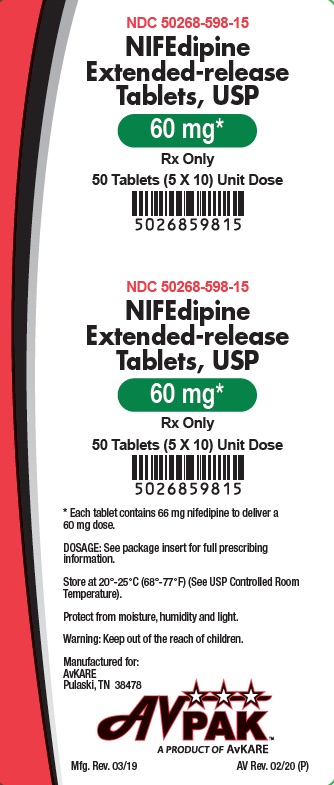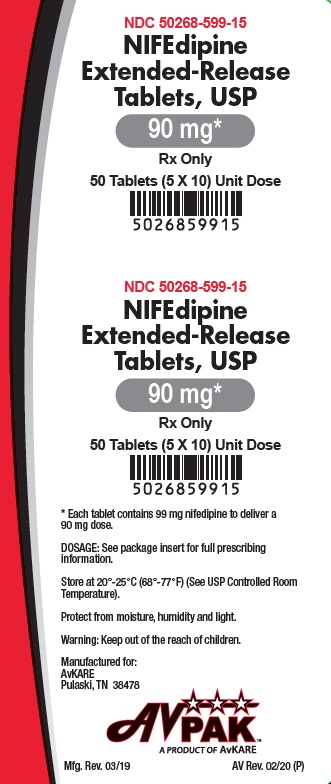Nifedipine ER
Generic name: nifedipine
Class: Calcium channel blocking agents
What is Nifedipine ER
Nifedipine ER 60 mg is an extended-release calcium channel blocker. The structural formula of nifedipine is 3,5-pyridine dicarboxylic acid, 1,4-dihydro-2,6-dimethyl-4-(2-nitrophenyl)-dimethyl ester, C17H18N2O6
Nifedipine ER is a yellow crystalline molecule that is essentially water-insoluble but ethanol soluble. It has a 346.3 molecular weight.
Nifedipine ER uses
Nifedipine ER is used to treat severe chest discomfort (angina) and excessive blood pressure (hypertension). High blood pressure burdens the heart and arteries. If it persists, the heart and arteries may be damaged. This can cause a stroke, heart failure, or kidney failure. High blood pressure raises the risk of a heart attack. Controlling blood pressure may help prevent these issues.
 Nifedipine ER blocks calcium channels. It operates by altering calcium transport into heart and blood vessel cells. As a result, nifedipine relaxes blood arteries, increasing blood flow and decreasing heart workload.¶
Nifedipine ER blocks calcium channels. It operates by altering calcium transport into heart and blood vessel cells. As a result, nifedipine relaxes blood arteries, increasing blood flow and decreasing heart workload.¶
Precautions and warnings
- It is vital that your doctor examine your progress regularly to ensure that the medicine is functioning correctly and to monitor for any adverse side effects.
- It is not recommended to take this medication if you are also taking any other medications, including
- Combining these medications could cause serious issues. Check with your physician about the exact medications you’re taking.
- Lightheadedness, dizziness, or fainting can occur, particularly when you suddenly get up from a sitting or lying posture. These signs tend to be more common as you begin to take this medication, or if you increase the dose.
- This medication may create swelling of the limbs (edema) in certain patients. Inform your doctor immediately when you experience swelling or bloating on the arms, face or hands, feet or lower legs or feet; tingling in the feet or hands, or an unusual weight loss or gain.
- Don’t discontinue taking this medication without first consulting with your physician. Your doctor may advise you to reduce gradually the amount of medication you’re taking before stopping all at once.
- Be sure that the dentist or doctor who treats you is aware that you’re using this medication. It is possible that you will have to stop taking this medication a few days prior to performing any medical or surgical procedures. This medication can influence the results of some medical tests.
- Grapefruits and grapefruit juice can enhance its effects on Nifedipine by increasing the quantity of this medication within the body. It is not recommended to eat wine or grapefruit juice when you take this medication.
- Do not take any other medications in the absence of discussing with your physician. This includes prescription and nonprescription (over-the-counter OTC) medicine, herbal and vitamin supplements.¶
Before using Nifedipine ER , consult your doctor
The hazards of taking a drug must be evaluated against the benefits. You and your doctor will decide. Considerations for this drug include:
Allergies
Mention any unexpected or allergic reactions to this or other medicines to your doctor. Tell your doctor if you have allergies to foods, colors, preservatives, or animals. Read the ingredients carefully on non-prescription products.
Pediatric
No studies on the impact of Nifedipine ER on children’s ages have been done. No evidence of safety or efficacy.
Geriatric
No geriatric-specific issues have been shown in investigations to date, limiting the use of Nifedipine ER in the elderly. However, elderly people are more prone to age-related renal, liver, or heart problems, necessitating prudence and dose adjustments.
Studies on women show that this medicine presents no harm to the baby when used while nursing.
Medicine interactions
While many medicines should never be used together, others may be used even if an interaction is possible. In certain circumstances, your doctor may alter the dose or take other precautions. It is critical that your doctor knows if you are using any of the following medications. The interactions listed below were chosen for their potential significance and are not all-inclusive.
Contraindications: This drug should not be used with any of the following medicines. Your doctor may adjust the dose or frequency of one or both medications if they are prescribed simultaneously.
Abametapir, Amobarbital
Aprobarbital
Armodafinil
Atazanavir
Boceprevir
Bosentan
Butabarbital
Butalbital
Carbamazepine
Ceritinib, Clarithromycin
Clobazam
Clopidogrel
Cobicistat
Conivaptan
Dantrolene
Dexamethasone
Digoxin
Efavirenz
Enzalutamide
Epirubicin
Etravirine
Fedratinib
Fentanyl
Fosnetupitant
Fosphenytoin
Itraconazole
Ketoconazole
Lacosamide
Lopinavir
Mephobarbital
Methohexital
Mibefradil
Modafinil
Nafcillin
Nefazodone
Nelfinavir , Netupitant
Nevirapine
Oxcarbazepine
Pentobarbital
Phenobarbital
Phenytoin
Posaconazole
Prednisone
Primidone
Rifabutin
Rifapentine
Ritonavir
Saquinavir
Secobarbital
Ayurveda
Telaprevir
Thiopental
Voriconazole
Using Nifedipine with any of the following may raise the chance of side effects, but it may be the best treatment for you. Your doctor may adjust the dose or frequency of one or both medications if they are prescribed simultaneously.
- Cimetidine
- Dalfopristin
- Micafungin
- Quinidine
- Quinupristin
- Tacrolimus
- Vincristine
- Liposome
Food/tobacco/alcohol interactions
Specific drugs should not be used right before or right after eating certain foods due to possible interactions. Alcohol and tobacco usage may potentially create drug interactions. The interactions listed below were chosen for their potential significance and are not all-inclusive.
Using Nifedipine ER with any of the following may raise the chance of side effects, but it is not always avoidable. Your doctor may adjust your dose or frequency of usage, or give you particular instructions about food, alcohol, or cigarettes.
Other health issues
Other medical issues may impact the use of this drug. Tell your doctor if you have any other health issues, especially:
- Aortic stenosis
- Bowel obstruction
- Congestive heart failure
- Coronary artery disease
- Heart attack
- Hypotension (blood pressure is low)
- Cardiogenic shock (shock caused by acute heart attack)
- Galactose intolerance
- Glucose-galactose malabsorption
Dosage and administration of Nifedipine ER
- The amount of nifedipine ER that is required to reduce angina and is acceptable to the patient needs to be determined by titration. In excess doses, it can cause hypotension.
- The therapy should begin by taking the dose of 10 mg. Start with one 10 mg capsule consumed whole, three times per day. The most effective dosage range is between 10-20 mg three times a day. Certain patients, particularly those who show signs of coronary artery spasms react only to greater doses or more frequent administration or both. For these patients, doses of 20-30 mg, three or every day may prove beneficial. Doses of more than 120 mg per day are not necessary. Anything more than 180 mg daily is not advised.
- In the majority of instances, nifedipine ER titration must be carried out over a 7-14-day time period to ensure that the physician will be able to assess the effect of each dose level and observe the blood pressure before moving on up to greater doses.
- If the symptoms warrant it the titration process to proceed quickly if the patient is monitored regularly. According to the individual’s levels of activity, frequency of attacks, and sublingual nitroglycerin intake the dosage of nifedipine ER can increase from 10 mg t.i.d. and up to 20 mg t.i.d. and then up to up to 30 mg t.i.d. over the course of three days.
- For patients in hospitals under close monitoring, The dose can be increased by small increments of 10 mg over 4 to six-hour intervals as needed to reduce arrhythmias and pain caused by Ischemia. A single dose shouldn’t exceed 30 mg.
- The co-administration of nifedipine ER and grapefruit juice should be avoided.
- There is no “rebound effect” has been observed after stopping the medication nifedipine. If the need to stop nifedipine ER arises good clinical practice suggests that dosage should be reduced gradually under close supervision of a physician.
- Co-administration with other Antianginal Drugs
- Sublingual nitroglycerin can be used to control acute angina manifestations, particularly during nifedipine-based dosage titration.
Nifedipine ER side effects
In large controlled studies where adverse reactions were observed spontaneously, there were a lot of adverse reactions but were not usually serious and seldom required the stopping therapy or dose adjustments. The majority of them were the result of the vasodilator effect of Nifedipine capsules.
| Adverse Effect | Nifedipine capsules (%) (N=226) |
Placebo (%) (N=235) |
|---|---|---|
| Dizziness, lightheadedness, and giddiness | 27 | 15 |
| The sensation of heat and flushing | 25 | 8 |
| Headache | 23 | 20 |
| Weakness | 12 | 10 |
| Nausea, heartburn | 11 | 8 |
| Muscle cramps, tremors | 8 | 3 |
| Peripheral edema | 7 | 1 |
| The mood can change, and anxiety may be present. | 7 | 4 |
| Palpitation | 7 | 5 |
| Dyspnea, cough, and wheezing | 6 | 3 |
| Nasal congestion Sore throat, nasal congestion | 6 | 8 |
There’s also an extensive uncontrolled situation in more than 2100 patients across the United States. The majority of patients suffered from the vasospastic form of angina pectoris or were resistant to it and about half were also receiving treatment with beta-adrenergic blockers. The most frequently reported adverse incidents included:
Incidence Approximately 10%
- Cardiovascular Edema in the peripheral region
- Central Nervous System: Dizziness, or lightheadedness
- Gastrointestinal: nausea
- Systemic: headache, flushing as well as fatigue
Incidence Approximately 5%
- CVS: Transient hypotension
Incidence 2% or Less
- Cardiovascular: palpitation
- Respiratory problems: chest and nasal congestion and shortness of breath
- Gastrointestinal: diarrhea, constipation, cramps, flatulence
- Musculoskeletal: inflammation, joint stiffness, muscle cramps
- Central Nervous System shaking and nervousness, jitteriness blurred vision, sleep disturbances problems with balance
- Other: dermatitis, pruritus, urticaria, fever, sweating, chills, sexual difficulties
Incidence Approximately 0.5%
- Cardiovascular Syncope (mostly in the initial dose or an increase in dosage)
- Eerythromelalgia
Incidence Less Than 0.5%
- Hematologic: thrombocytopenia and anemia Leukopenia and purpura
- Gastrointestinal: allergic hepatitis
- The face and the thrombus: angioedema (mostly oropharyngeal edema that causes breathing difficulties in a handful of patients) gingival hyperplasia
- CNS: depression, paranoid syndrome
- Special Senses: temporary blindness at the top of plasma levels Tinnitus, transient blindness
- Urogenital: polyuria, nocturia
- Other symptoms include arthritis, ANA (+), Exfoliative Dermatitis, and Gynecomastia
- Musculoskeletal: myalgia
Many of these side effects are thought to be related to dose. Peripheral edema was seen in approximately 25 percent of patients who took doses below 60 mg daily and in one patient with a dose of 120 mg daily or more. Hypotension transient, usually moderate to mild in severity, and rarely requiring the stopping therapy, occurred in one patient who took less than 60 mg/day and in one patient who took 120 mg daily or greater.
Very rarely, the introduction of Nifedipine ER capsules for therapy was related to an increase in pain in the angular region which could be due to hypotension. A temporary loss of vision unilaterally is also a possibility.
Furthermore, more severe adverse events were also observed that were not easily distinguished from the normal history of the illness in the patients. There is a chance that some or all of these events are connected. Myocardial infarction was reported in around 4 percent of patients, while the congestive heart condition or lung edema that occurred was approximately two percent. Conduction disturbances or arrhythmias occur in less than 0.5 percent of patients.
What if I missed dose
If you are missing a dose of this medicine make sure you take it as quickly as you are able. If it’s nearing the time to take the next dose, you can skip the missed dose, and go back to your usual dosage schedule. Do not take double doses.
Storage
Keep the medicine in a tightly sealed bottle at room temperatures, and away from moisture, heat, and bright light. Avoid the medicine from freezing.
Keep your items out of children’s reach.
Don’t keep old medicine or medications that are no longer needed.
Consult your physician about what you can do with any medication that you do not make use of
How supplied
Nifedipine ER 30 mg
- The pills are round, biconvex, pink-coated tablets imprinted in black writing with “KU 260.” NDC 50268-597-15 is the number assigned to them (10 tablets per card, 5 cards per carton)

Nifedipine ER 60 mg
- The pills are round, biconvex, pink-coated tablets imprinted in black ink with “KU 261.” NDC 50268-598-15 is the number assigned to them (10 tablets per card, 5 cards per carton)

Nifedipine ER 90 mg
- The pills are round, biconvex, pink-coated tablets imprinted in black ink with “KU 262.” NDC 50268-599-15 is the number assigned to them (10 tablets per card, 5 cards per carton)

More details
Always consult your doctor to make sure the information presented on this site is appropriate to your particular situation.
